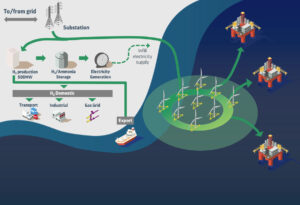Cerulean Winds urges government action to proceed with decarbonization of UK’s offshore oil and gas assets

Green infrastructure developer Cerulean Winds has revealed a plan to accelerate decarbonization of oil and gas assets through an integrated 200-turbine floating wind and hydrogen development.
The £10 billion proposed green infrastructure play would have the capacity to abate 20 million tonnes of CO2through simultaneous North Sea projects West of Shetland and in the Central North Sea. A formal request for seabed leases has been submitted to Marine Scotland.
Cerulean Winds is led by entrepreneurs Dan Jackson and Mark Dixon, who have more than 25 years’ experience working together on large-scale offshore infrastructure developments in the oil and gas industry. They believe the risk of not moving quickly on basinwide decarbonization would undermine the objectives set out in the recent North Sea Transition Deal.
“The UK is progressing the energy transition, but a sense of urgency and joined-up approach is required to enable rapid decarbonization of oil and gas assets or there is a risk of earlier decommissioning and significant job losses,” Mr Jackson said. “Emissions are quite rightly no longer acceptable, but with emissions penalties and taxes coming, the UK oil and gas industry’s role in homegrown energy security during the transition could be threatened unless current decarbonization efforts can be greatly speeded up. The consequences of not moving quickly enough will be catastrophic for the economy and the environment.”
The Cerulean leadership has Tier 1 contractors in place to deliver the UKCS backbone development and has engaged the financial markets for a fully funded infrastructure construct.
The proposed development involves:
- Over 200 of the largest floating turbines at sites West of Shetland and in the Central North Sea with 3GW per hour of capacity, feeding power to the offshore facilities and excess 1.5 GW per hour power to onshore green hydrogen plants.
- Ability to electrify the majority of current UKCS assets, as well as future production potential from 2024, to reduce emissions well ahead of abatement targets.
- 100% availability of green power to offshore platforms at a price below current gas turbine generation through a self-sustained scheme with no upfront cost to operators.
- The development of green hydrogen at scale and £1 billion hydrogen export potential.
- No subsidies or CFD requirements and hundreds of millions of pounds to government revenue via leases and taxation through to 2030.
Cerulean has undertaken the necessary infrastructure planning for the scheme to ensure the required level of project readiness, targeting financial close in Q1 2022. Construction would start soon after, with energization commencing in 2024. An Infrastructure Project Finance model, commonly used for major capital projects is being adopted.
Société Générale, a leading European financial services group, is advising Cerulean Winds. Allan Baker, Global Head of Power Advisory and Project Finance, commented: “The Cerulean UKCS decarbonization project has the potential to meet all of the basin’s transition needs by reducing oil and gas emissions as quickly as possible whilst also introducing large-scale green energy. We are pleased to be supporting the leadership on what is a transformational proposition for the UK.”
Cerulean estimates that the current 160,000 oil and gas jobs can be safeguarded and 200,000 new roles within the floating wind and hydrogen sectors will be created within the next five years.
Mr Jackson added: “We have a transformative development that will give the UK the opportunity to rapidly decarbonize oil and gas assets, safeguard many thousands of jobs and support a new green hydrogen supply chain. The decision to proceed with the scheme will ultimately rest with the Scottish government and Marine Scotland and their enthusiasm for a streamlined regulatory approach. The ask is simply that an exceptional decision is made for an extraordinary outcome. We are ready to deliver a self-sustained development that will decarbonize the UKCS and be the single biggest emissions abatement project to date.”




